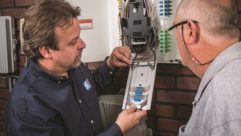CCTV VIDEO TROUBLESHOOTING
Jun 1, 2002 12:00 PM,
DON McCLATCHIE
- KNOWLEDGE, AS THEY SAY, IS the key to success, which certainly applies to the installation and maintenance of CCTV camera equipment. Have you ever installed a system and then had to go back to solve a problem that was overlooked? A basic understanding of CCTV video signals can save you hundreds of hours, improve customer relations and increase job profitability — all at the same time. Knowing the fundamentals of CCTV operation will help you troubleshoot systems effectively.
- Setting Synch Pulse Amplitude. A CCTV video camera creates synchronization pulses to lock the viewing monitor on the picture. These pulses occur at a rate of 15,750 times per second. There is one synchronization pulse (or sync pulse) for each line in the picture frame. The sync pulse tells the video monitor to start drawing a video line across the picture screen. When it gets to the end of the screen, another synchronization pulse begins the next line until the screen has been filled. It takes 262½ lines to form a frame and two frames to form the video picture seen on the monitor.The proper level for sync is 40 IRE units. If the sync signal from the camera is too low in amplitude, the picture will break up or roll. If the sync pulse is too big, any black portion of the picture will be grayer, and the dynamic range of the picture will be degraded. Peak white level will also be compressed, causing a blooming effect (loss of picture definition).
- White Level Iris Setting. How much is enough? The standard for iris setting, or white level, is 100 IRE units. Whether you’re setting a manual iris or an automatic iris, the level should be the same. If you set the iris below 100 IRE units, the picture will be dim with low dynamic range, and the white picture elements will not be pure white. If you set the iris for more than 100 IRE units, the picture can be washed out, causing loss of picture definition.Some cameras can be set to 120 IRE units, but the standard is 100, and all cameras in the system should be set to the same level of white. That ensures that the white portion of the picture will have the same brightness when a monitor is switched between them.
- Peak-to-Peak Measurement. A quick measurement of the peak-to-peak video signal will reassure you that the CCTV camera is putting out the right level. The standard is 140 IRE units.
- Color Cameras and Color Burst. More color cameras are being used in CCTV installations nowadays. The color camera adds a chrominance component (color information) to the signal. This is also known as chroma. The chroma signal operates at 3.58 MHz, and the standard level is 40 IRE units. When the chroma level is low, the colors will be dull. If this level is too low, the color monitor will turn its color receiver off, and the picture will be black and white. This also causes a loss of picture detail. You can see this effect on long cable runs.The solution is to install a video equalizer in the line and adjust the color burst back to 40 IRE units. If the chroma signal is too high, the picture will display color flaring and reduction of detail at the edge of the color flare.
- Vertical Interval. The VI is the part of the video signal that tells the monitor to start drawing a new screen. It is made up of special sync pulses with no picture elements. The standard level for these sync pulses is also 40 IRE units. The VI is useful place to put alarm and control signals. Some manufacturers make equipment for pan and tilt camera control, alarm contact information and data transmission that is inserted into the VI signal and sent up or down the cable.
- Line Termination. A termination for video is a 75• resistor placed at the end of any video cable to prevent signal reflections that cause ghosting or multiple images on the monitor. Some CCTV components have built-in terminations, some of which are switchable. If you are using this equipment in series, you must switch off all terminations except the termination at the last piece of equipment in the cable run. Proper termination can be checked by measuring the sync pulse amplitude anywhere in the video cable.It should read 40 IRE with the termination on and 80 IRE with the termination off. If the sync level does not change when you remove the termination, the camera or video source is not the standard 75• and should be serviced or replaced. Problems with VI control systems can result if the level does not double when you remove the termination.The Basic Three. To check performance of any CCTV camera installation, make sure the sync level is 40 IRE units ±5. White level should be 100 IRE units ±5. If you want to run high white level (120 IRE), be sure that all cameras in the system have the same level ±5 IRE. Color burst level should be 40 IRE units ±5. Sync, white level and color burst are the three basic measurements used for proper operation of a CCTV system.
Don McClatchie is the COO of FM Systems and an expert in the field of security equipment.
The Measure of Success: IRE Units
To measure video, we use the IRE unit. IRE stands for Institute of Radio Engineers, the regulating body that sets the standards of measure for the video industry. This standard has been adopted by all industries in the United States and other parts of the world. One hundred forty IRE units equals 1 V peak to peak. IRE units are easier to use because they divide into a video signal evenly. For example, proper sync on a camera is 40 IRE units. The voltage equivalent would be 0.2857 V, a voltage that cannot be measured on the volt ohm milliammeter that you use for checking contacts. An oscilloscope has been used by some for this purpose, but it is bulky and does not read IRE.
Fortunately some equipment manufacturers sell hand-held, battery-operated meters to measure video signal in IRE units. This equipment is compact, extremely accurate and simple to use. Some units, such as the Camera Master, can even help to set the focus of a camera more accurately.









